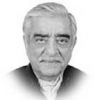View from Pakistan: Afghan peace needs a proper economic plan

Following a six-day marathon session of talks between the Afghan Taliban and Zalmay Khalilzad in Doha, the US special representative announced that “progress had been made”. This progress, says the Economist, had “all four main elements of the deal — the exclusion of international terrorists, an American withdrawal, a ceasefire and talks between the Taliban and the government — as an indivisible package”.
Mr Khalilzad said, “Nothing is agreed until — everything is agreed”, and “‘everything’ must include an intra-Afghan dialogue and comprehensive ceasefire”.
Many “learned” comments and “disclosures” by American, Afghan, Pakistani, Iranian, Russian and Indian analysts have followed. In many commentaries, there is an underlying understanding that failure of reconciliation will unhinge the region with the greatest impact on Pakistan. Despite fencing, Pakistan will be the recipient of economic and political refugees and chaos in regions bordering Afghanistan.
The most important developments, then, are what President Trump and Secretary Pompeo have said about US intent. In a recent interview to CBS, Trump said he planned to keep a small contingent in Afghanistan for “real intelligence” purposes and that US forces would return to the country if necessary. Ghani, in a letter to Trump, said he could offer to reduce by $2 billion the amount needed to support the Afghan National Defence and Security Forces but also made it clear that assistance was needed to continue for an extended period.
The US intelligence community in congressional hearings expressed scepticism about a peace deal being reached but said that if it did happen the recommendation is “to maintain pressure”, and that “a very robust monitoring regime would be needed” — in effect, calling for a US counterterrorism presence and implicit continuance of financial assistance to ensure the peace deal’s implementation.
The meeting in Moscow with the Taliban was ongoing as I wrote this. The ostensible purpose is to pave the way for Taliban talks with the Afghan government. This is the brainchild of Zamir Kabulov, the Russian representative for Afghanistan and perhaps the most knowledgeable foreign observer of internal Afghan dynamics.
Currently, however, this meeting only serves to underline the resurrection of the Northern Alliance and sends out the signal that Afghanistan will return to the position of having the Taliban control much of the territory but face a Northern Alliance in the north.
A sustainable peace in Afghanistan is dependent on the following economic factors:
Afghanistan’s exports are about $1.1 billion while its imports exceed $8bn. These imports — provide much of its tax revenue and generate employment. Its imports from the UAE, for the most part, are of items smuggled into Pakistan; these will have to dry up as part of the implementation of Afghanistan-Pakistan Action Plan for Peace and Solidarity.
It must continue to receive assistance beyond 2024, perhaps up to 2030, before exploitation of its strategic location to provide connectivity between South and Central Asia.
Last year, over 800,000 Afghans were expelled from Iran while some 30,000 returned from Pakistan. This year, more will return from Iran. Supporting these returning refugees places another burden on the Afghan government’s finances.
Opium production dropped from 9,000 tons last year to 6,400 tons this year and the farm-gate has come down to $94 per kilogram — a welcome development but a contributor to rural unemployment and economic hardship for farmers, again creating new demands for financial assistance.
No regional country or group of regional countries comes close to providing such assistance. This financial support can come only from the US. Some argue that Europe too must join in to provide such support, or else there will be another mass exodus of Afghans seeking asylum in Europe and — exacerbating the migration problem. If aid continues at present or reduced levels, Ghani has proposed it will constitute, along with the — envisaged CT presence, less than 6 per cent to 7per cent of the $716 billion US defence budget, a small price to pay for sustained Afghan peace.
By arrangement with Dawn

